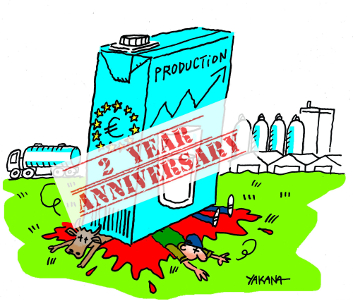When the promise of a soft landing turns into a real crash

Two years after the announcement that led to the end of the dairy quota regime March 31, 2015, no glimmer of hope looms on the horizon of dairy producers. Today, the majority of dairy producers in Europe continue to sell every kilo of milk at a loss.
The stock of milk powder amounts to 418.978 million Tm. What’s more, springtime has come, and we’re in the eve of taking our cows out to the meadows, we therefore expect a very significant increase in production. To this we must add, that the consumption of liquid milk is declining in many countries in the EU.
Abandoning their farms is the only way out for thousands of producers. In Spain, within two years, 1,696 of the 17,000 farms that existed before the abolition of quotas have disappeared.
In the meantime, the agri-industry is growing and spreading. Multinational corporations such as Lactalis keep strengthening their power. In many countries in Europe, they seek to implement industrial projects of mega-dairy farms. In France, there is the constant attempt to set up farms with 1,000 cows. In Spain, in the province of Soria, Castile and León, there is the plan to install a macro-farm of 20,000 cows.
It is estimated that this last project alone will consume between 4 and 6.35 million liters of water per day and produce 368,000 tons of manure per year, the equivalent of a population of nearly 4.4 millions of people. Only 44 farms of this size could produce, in a hypothetical future, the quantity of milk produced in Spain in 2016 by more than 15,000 small and medium-sized dairy farms.
The implementation of these projects and the destruction of thousands of family farms that go with them are facilitated by the abolition of milk quotas. This deregulation policy is tailored for large-scale distributors and the dairy industry, but is disastrous to producers and consumers.
So far, the responses to the market crisis have been individual approaches, such as voluntary reductions, voluntary indication of the origin of milk, along with national support measures. However, since there is only one market, the positive impact of these initiatives is irrelevant.
Only the restoration of a public instrument for regulating production, limiting the development of large farms and preventing the implementation of these macro-dairy projects will be able to curb the destruction of the European dairy sector and preserve the quality and sustainability of our production model.
Contact : Andres Arce Indacochea (Communication Officer) – andres@eurovia.org, +32 489 55 22 97
